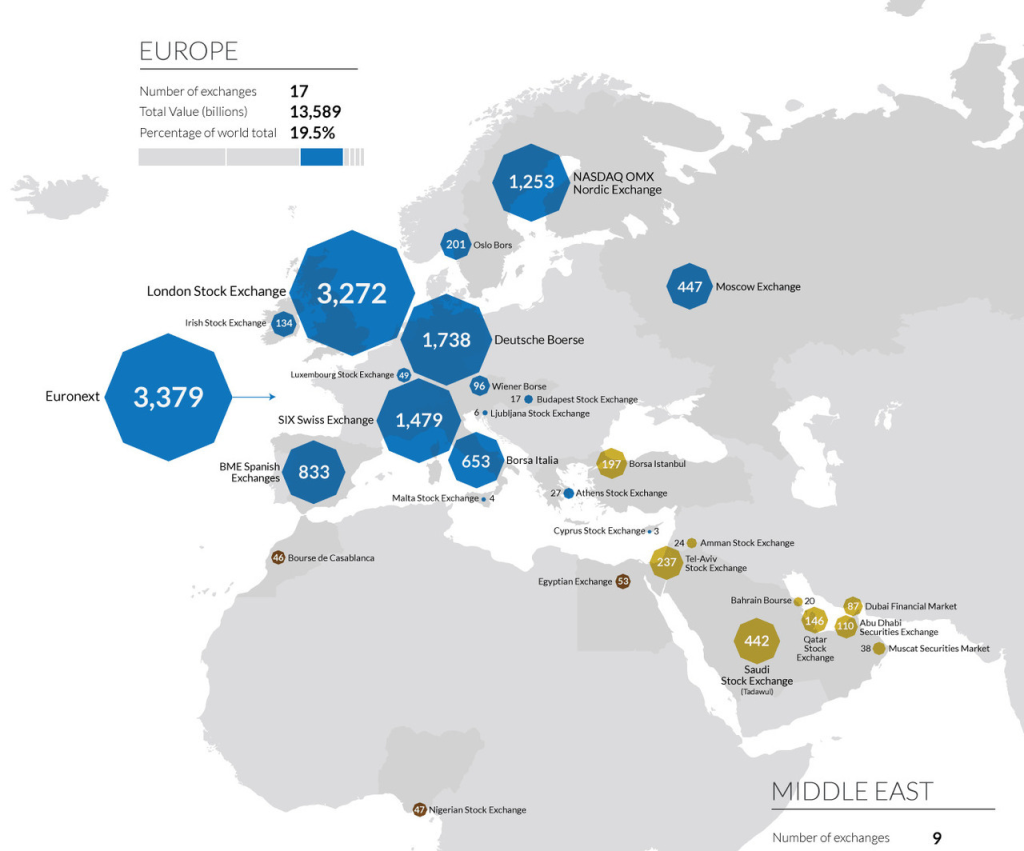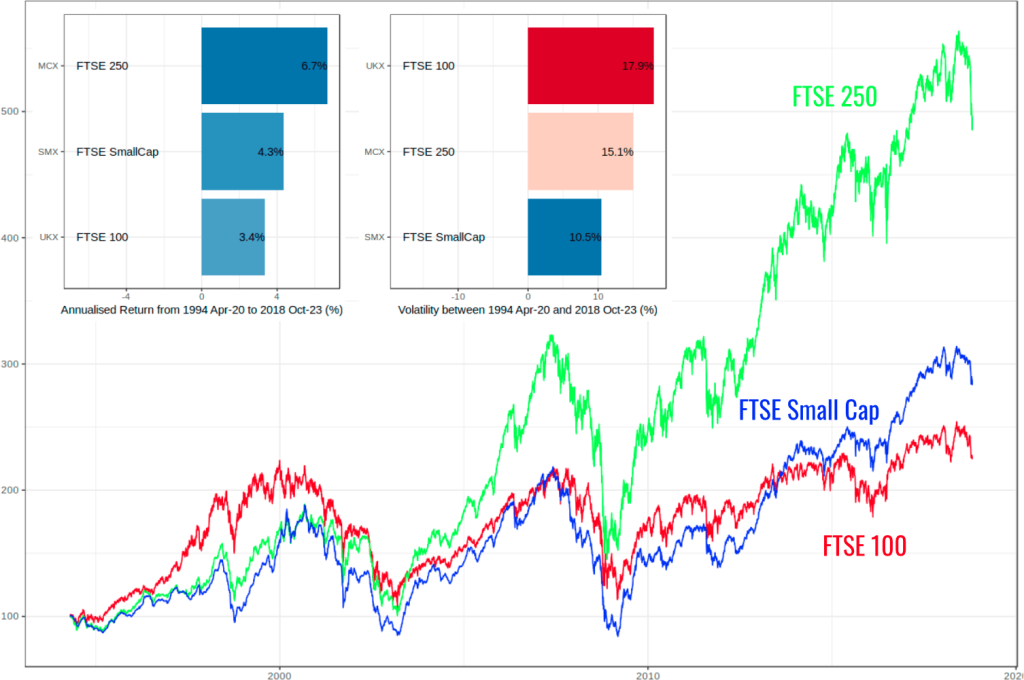Local: Market Capitalization and Enterprise Value in the European context
Malengo ya Somo:
- Elewa market capitalization and its importance in evaluating the size and financial strength of companies on major European exchanges like the London Stock Exchange na Deutsche Börse. This knowledge is crucial for making informed investment decisions.
- Learn to differentiate between large-cap, mid-cap, na small-cap companies, recognizing how each category affects investment risk and potential returns. This classification aids investors in tailoring their investment strategies to match their risk tolerance and financial goals.
- Grasp how market capitalization influences the composition and performance of major indices such as the FTSE 100 na DAX. Understanding this can help investors interpret market movements and optimize their investment portfolios.
- Discover the role of market capitalization in comparing different stock exchanges globally, using tools like the map of global stock exchanges by market cap. This comparative analysis is beneficial for identifying regional financial hubs and investment opportunities.
23.1 Market Capitalization
In the European context, market capitalization is a key metric used across major stock exchanges such as the London Stock Exchange (LSE) na Deutsche Börse’s DAX to gauge the size and value of publicly traded companies. Market capitalization represents the total market value of a company’s outstanding shares and is commonly used to categorize companies into large-cap, mid-cap, and small-cap categories.
Market Capitalization on European Stock Exchanges
London Stock Exchange (LSE): The LSE, one of Europe’s largest and most established stock exchanges, lists companies with varying market capitalizations, from large multinational corporations to smaller, growing firms. Large-cap companies listed on the LSE include globally recognized names such as HSBC, Unilever, na BP. These companies tend to have market capitalizations in the billions, placing them in the large-cap category.
- For instance, HSBC, one of the largest banks in the world, has a market capitalization exceeding £100 billion. Investors use this figure to understand its scale and compare it with other financial institutions across Europe and globally.
DAX (Deutsche Börse):The DAX is Germany’s primary stock index, representing 30 of the largest and most liquid companies on the Frankfurt Stock Exchange. The market capitalization of companies in the DAX provides insight into the health and size of Germany’s economy. Firms like Siemens, Volkswagen, na BASF are well-known DAX constituents, each with market capitalizations in the tens or hundreds of billions of euros.
- Siemens, a global leader in industrial manufacturing, regularly features a market capitalization of over €100 billion. Market capitalization is crucial for determining Siemens’ relative size within the European industrial sector.
23.2 Market Capitalization Categories in Europe
European stock exchanges, like the LSE and DAX, classify companies into three main categories based on market capitalization:
- Large-Cap: Companies with a market capitalization of €10 billion or more. These firms tend to be well-established, with stable earnings and a strong market presence. Examples include Nestlé, Royal Dutch Shell, na SAP.
- Mid-Cap: Companies with a market capitalization between €2 billion and €10 billion. These are often firms experiencing growth, but they may not have the same stability or global reach as large-cap companies. Examples include MTU Aero Engines in Germany or Ocado Group in the UK.
- Small-Cap: Companies with a market capitalization below €2 billion. These firms are typically smaller, with higher growth potential but greater risk. Small-cap stocks are more prevalent on alternative markets like the FTSE AIM in the UK or MDAX in Germany.

Kielelezo: Map of Global Stock Exchanges by Market Cap (Europe & Middle East)
Maelezo:
This map displays the market capitalizations of various stock exchanges across Europe and the Middle East. Each exchange is represented by a hexagon, with the size indicating the relative market cap in billions of dollars. The largest exchanges include Euronext ($3,379B), London Stock Exchange ($3,272B), and Deutsche Börse ($1,738B) in Europe. The total value of exchanges in Europe is $13,589B, representing 19.5% of the global total. In the Middle East, the largest market caps are seen in the Saudi Stock Exchange ($442B) and Dubai Financial Market ($144B).
Mambo muhimu ya kuchukua:
- Euronext na London Stock Exchange are the largest exchanges in Europe by market cap.
- Europe’s exchanges account for nearly 20% of the world’s total market capitalization.
- Saudi Stock Exchange dominates the Middle East in terms of market cap.
- The map provides a visual comparison of market sizes, highlighting regional financial hubs.
Utumiaji wa Taarifa:
Understanding stock exchange sizes helps investors assess the scale and influence of different financial markets globally. This information is useful for analyzing regional market opportunities, determining ukwasi levels, and evaluating investment environments within Europe and the Middle East.
23.3 Market Capitalization as a Benchmark in European Indices
In Europe, market capitalization is not only used to classify companies but also plays a critical role in the composition of stock market indices. For instance, the FTSE 100 index is made up of the 100 largest companies listed on the LSE, ranked by market capitalization. Similarly, the DAX selects its 30 constituents based on market cap and liquidity.
The market capitalization of a company determines its weight in these indices, affecting how much influence it has on the overall performance of the index. Larger companies like BP au Volkswagen tend to have a greater impact on the index movements due to their significant market cap compared to smaller firms.

Kielelezo: Performance and Volatility of FTSE 250, FTSE Small Cap, and FTSE 100
Maelezo:
This graph compares the performance and volatility of three major UK indices: the FTSE 250, FTSE Small Cap, na FTSE 100 from 1994 to 2018. The main chart shows the growth trajectory of the indices over time, with the FTSE 250 having the highest returns (green line), followed by the FTSE Small Cap (blue line), and FTSE 100 (red line). The bar charts on the top left indicate the annualized returns, with the FTSE 250 achieving the highest return at 6.7%, while the FTSE 100 recorded the lowest at 3.4%. The bar charts on the top right highlight volatility levels, where the FTSE 100 experienced the highest volatility at 17.9%, na FTSE Small Cap had the lowest at 10.5%.
Mambo muhimu ya kuchukua:
- The FTSE 250 outperformed the FTSE 100 na FTSE Small Cap in terms of annualized returns.
- The FTSE 100 experienced the highest volatility, making it the riskiest of the three indices.
- The FTSE Small Cap had the lowest volatility, indicating more stability despite lower returns.
- The growth trends indicate that mid-cap stocks (FTSE 250) often achieve higher returns compared to large-cap (FTSE 100) and small-cap stocks (FTSE Small Cap).
Utumiaji wa Taarifa:
Investors can use this information to understand the risk-return trade-off between different market cap indices. While mid-cap investments (FTSE 250) may offer higher returns, they are generally more volatile than smaller caps but less volatile than large caps. This helps in making portfolio allocation decisions based on uvumilivu wa hatari na investment goals.
Hitimisho
In European markets, market capitalization is an essential metric used to determine the size and value of a company. Whether trading on the London Stock Exchange, Frankfurt Stock Exchange, or other European exchanges, market capitalization helps investors understand a company’s position in the market, compare it with peers, and classify it into large-cap, mid-cap, or small-cap categories. This metric also plays a pivotal role in the composition and performance of major European stock indices like the FTSE 100 and DAX, guiding investment decisions across the continent.
Habari Muhimu ya Somo:
- Market capitalization is a primary indicator used to gauge the size and value of companies across European stock exchanges, essential for investment and strategic decision-making.
- The classification into large-cap, mid-cap, na small-cap is pivotal in investment strategies, influencing both the risk profile and the potential growth of investments.
- Indices like the FTSE 100 na DAX utilize market capitalization to determine a company’s influence on the index’s performance, reflecting its significance in overall market movements.
- Kuelewa market capitalization of stock exchanges through visual tools like maps can enhance investors’ ability to evaluate and compare financial markets, aiding in the diversification and geographical allocation of their investment portfolios.
Taarifa ya Kufunga:
Mastering the concept of market capitalization is fundamental for any investor involved in European markets. This section provides you with the tools to assess company size, understand market dynamics, and make strategic investment decisions based on company classifications and index compositions.

